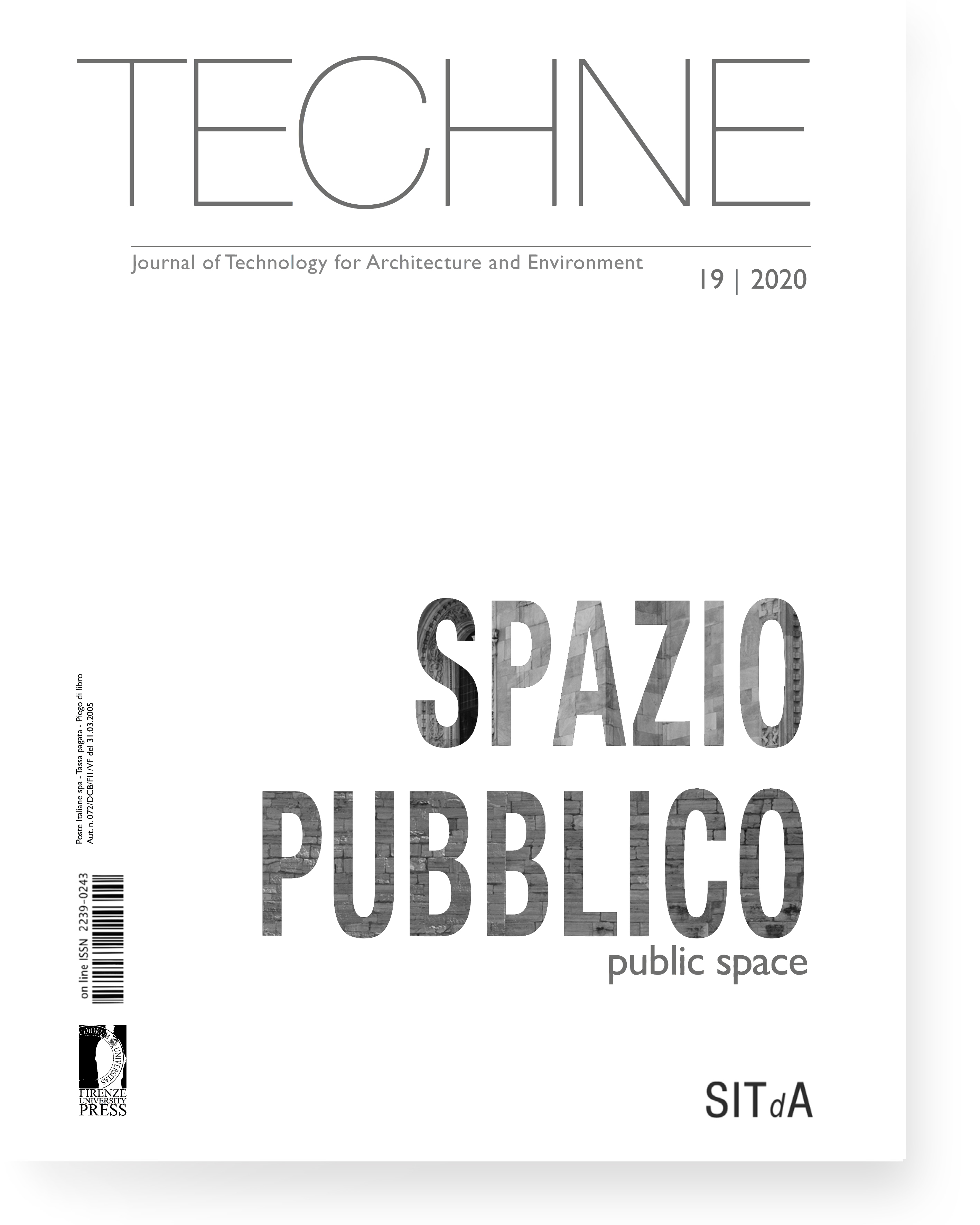Published 2020-01-21
How to Cite
Abstract
The urban project reflects a scientific feature that can be considered as the harmonious outcome between concepts related to both planning and architectural scale, starting from a process of site analysis where rules and metrics are taken from.
The urban context is also to be understood as a more or less large portion of landscape, mostly anthropized and natural; it is influenced in its development by the exchanges that are generated among fields ranging from the urban economy to the procedural dimension, passing through mobility, the definition of identity of places, and arrive at the rational management of resources, safety, accessibility and well-being of users (Losasso, 2017).
More specifically, the development of urban space, and consequently the way the built landscape changes, has significant effects on the type and quality of the activities carried out by its users (Gehl, 1987 - Dessì, 2007) and on the possibilities of preserving and implementing the functional connections between parts of the city and between city and territory (Lynch, 1990).
Philip Pregill deals with many of these topics, exploring the relationship between the old and new features of the city and the built landscape, in the book mainly intended as part of the physical space for pedestrian activities. The sidewalk, the one we walk on every day, assumes thus the role of a strategic indicator, able to gauge the social, environmental and physical changes of the contemporary city.
The author shows interest and skill in matching the theme of design and enhancement of the urban context with the characterization of public and semi-public open spaces; here intended as spaces designed for stationary activities and on-the-move activities of citizens.
He does so in seven chapters, wherein the term “connections” is five times used in the header; demonstrating that one of the main duties of pedestrian areas is precisely to connect existing and developing places within the urban scene.
In the beginning, the book emphasizes the importance of designing urban spaces organized through hierarchical grids. It describes some cities historically designed mostly according to orthogonal urban models; cities in which it is possible to grasp the distinction between main and secondary axes.
Three types of urban landscape are defined in order to carry out pedestrian activities: the “arterials”, described as access avenues and main connection between poles of the city; the “collectors”, defined as city axes of the second level concerning the arterials, and aimed at connecting poles that characterize a neighborhood; the “local connections”, considered as the one that links the previous categories to the everyday living places.
Each urban connection is described through an inductive approach, as defined by the author; in other words, it is intended to design the new or enhance the existing one according to a cultural and scientific heritage made up of examples, good practices and technical reference standards.
At the same time, however, another method is highlighted defined by Pregill as deductive. A system focused on bottom-up phenomena; e.g. experiences of tactical urbanism and guerrilla gardening are accurately described in the book.
Thus, culturally different approaches coexist, because of the complexity of the theme. Technical standards can make an urban space adequately lighted or well-organized in terms of mobility, but it is often the citizens’ participatory designs that contribute to making a part of the built landscape as unique and identifiable, helping to strengthen the sense of belonging of the users.
Pregill provides the reader with an interdisciplinary interpretation of the urban space, conceived as the result of a typological, compositional and landscape control and as a scenario within different types of users require the meeting of needs related to safety, usability and, more generally, livability.
The pedestrian landscapes are therefore the outcome of an anthropocentric vision of the project. They are designed for the physical and psychological well-being of people in relation to the various spaces in which they perform dynamic or static activities. A vision in relation and analogy with research topics close to the technological design culture.
The last chapters of the book deal with the development of contemporary and future connections of pedestrian landscapes. Both deductive and inductive approaches are also proposed. On the one hand, the author suggests smart cities and smart streets as reference models able to improve the services of urban space, as well as information technology as an opportunity to shape places that can change their configurations according to certain safety and well-being requirements. On the other hand, it recalls the core role of the user as a holder of individual experiences capable of influencing the urban identity of a place, beyond the number and quality of the technological gadgets it is equipped with.
Finally, in several parts, the book encourages solutions to tackle, or at least mitigate, one of the main contemporary challenges such as climate change. The pedestrian landscape thus becomes an opportunity to reduce urban heat island or urban flooding.
The urban spaces, where possible, should be designed according to proper orientations and morphologies able to minimize the rising temperatures. But most importantly, Pregill recognizes in the vegetation use systemic properties. Vegetation can perform a variety of functions: it shades the walking and standing areas; it can reduce the superficial temperature of urban materials (starting from the sidewalks); it can improve the rainwater drainage through rain gardens.
On the whole, the book provides a collection of useful instructions for a variety of stakeholders; although it is primarily aimed at the academic community, many paragraphs deal with strategies and solutions useful to public authorities, designers and architects engaged in various fields: urban, architectural and, last but not least, technological. Strategies and solutions capable of developing new urban and contemporary landscape models designed for living, not just for rapid transits.







